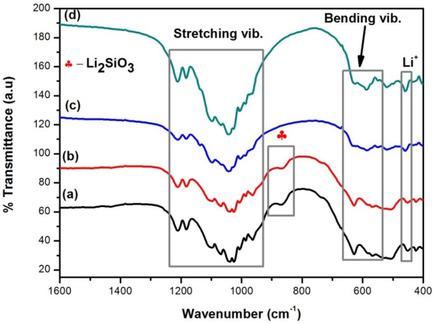当前位置:
X-MOL 学术
›
Electroanalysis
›
论文详情
Our official English website, www.x-mol.net, welcomes your
feedback! (Note: you will need to create a separate account there.)
Graphenised Lithium Iron Phosphate and Lithium Manganese Silicate Hybrid Cathodes: Potentials for Application in Lithium‐ion Batteries
Electroanalysis ( IF 2.7 ) Pub Date : 2020-10-07 , DOI: 10.1002/elan.202060435 Assumpta Nwanya 1 , Zolani Myalo 2 , Chinwe Ikpo 3 , Miranda Ndipingwi 3 , Samantha Douman 4 , Kefilwe Mokwebo 2 , Emmanuel Iwuoha 5
Electroanalysis ( IF 2.7 ) Pub Date : 2020-10-07 , DOI: 10.1002/elan.202060435 Assumpta Nwanya 1 , Zolani Myalo 2 , Chinwe Ikpo 3 , Miranda Ndipingwi 3 , Samantha Douman 4 , Kefilwe Mokwebo 2 , Emmanuel Iwuoha 5
Affiliation

|
Sol‐gel and hand milling techniques were used to prepare a lithium iron phosphate‐lithium manganese silicate (LiFePO4−Li2MnSiO4) hybrid cathode materials. The structural studies from x‐ray diffraction (XRD) and high resolution transmission electron microscopy (HRTEM) show that the materials are well crystallized although few impurities were observed in the pristine LiFePO4 (LFP) and Li2MnSiO4 (LMS) materials. We used graphene to coat the hybrid cathode materials in order to increase its conductivity and enhance the electrochemical performance. The successful reduction of the graphene oxide into graphene nanosheets was confirmed with the results from the Fourier transform infrared (FTIR) and Raman spectroscopy. The morphological analysis indicate that the pristine materials are made of spherical nanoparticles that are slightly agglomerated while the sol‐gel‐prepared hybrid cathode materials show evenly distributed spherical nanoparticles with minimal agglomeration. The in situ sol‐gel technique gave more homogenously mixed material in comparison to the hand milling method and particle sizes of 37 and 23 nm respectively were obtained for the plain, and graphenised sol gel derived hybrid materials. The sol‐gel derived hybrid materials are also the most thermally stable giving a total weight loss of 4.5 % and 3.4 % for the plain and graphenised cathodes respectively. While the LFP‐LMS hybrid cathode materials performed better electrochemically more than the pristine materials in terms of enhanced current and specific capacities, the graphenised LFP‐LMS hybrid cathode materials showed better electrochemical properties compared to those without graphene. This is associated with the presence of graphene nanosheets in these samples. All the results confirmed that the graphenised LiFePO4−Li2MnSiO4 hybrid cathode material prepared via in situ sol‐gel method performed better than those of the hand milling method.
中文翻译:

Graphenized磷酸铁锂和硅酸锰锂锂混合阴极:在锂离子电池中的应用潜力
溶胶-凝胶和手磨技术用于制备磷酸锂铁锂硅酸锰锂(LiFePO 4 -Li 2 MnSiO 4)混合阴极材料。X射线衍射(XRD)和高分辨率透射电子显微镜(HRTEM)的结构研究表明,尽管在原始的LiFePO 4(LFP)和Li 2 MnSiO 4中观察到的杂质很少,但材料结晶良好。(LMS)材料。我们使用石墨烯涂覆混合阴极材料,以增加其电导率并增强电化学性能。傅里叶变换红外(FTIR)和拉曼光谱的结果证实了氧化石墨烯成功还原为石墨烯纳米片。形态分析表明,原始材料是由球形的纳米颗粒组成的,球形纳米颗粒略有团聚,而溶胶凝胶制备的混合阴极材料显示的球形纳米颗粒分布均匀,团聚最少。在原位与手工研磨方法相比,溶胶-凝胶技术可提供更多均匀的混合材料,而普通的和石墨化的溶胶-凝胶衍生的杂化材料的粒径分别为37和23 nm。溶胶-凝胶衍生的杂化材料也是最热稳定的,平原和石墨化阴极的总重量损失分别为4.5%和3.4%。虽然LFP-LMS混合阴极材料在电化学性能方面比原始材料更好,但在增强电流和比容量方面却表现出色,但石墨化LFP-LMS混合阴极材料与不使用石墨烯的材料相比,电化学性能更好。这与这些样品中石墨烯纳米片的存在有关。所有结果证实了石墨化的LiFePO 4通过原位溶胶-凝胶法制备的-Li 2 MnSiO 4杂化正极材料的性能优于手磨法。
更新日期:2020-12-01
中文翻译:

Graphenized磷酸铁锂和硅酸锰锂锂混合阴极:在锂离子电池中的应用潜力
溶胶-凝胶和手磨技术用于制备磷酸锂铁锂硅酸锰锂(LiFePO 4 -Li 2 MnSiO 4)混合阴极材料。X射线衍射(XRD)和高分辨率透射电子显微镜(HRTEM)的结构研究表明,尽管在原始的LiFePO 4(LFP)和Li 2 MnSiO 4中观察到的杂质很少,但材料结晶良好。(LMS)材料。我们使用石墨烯涂覆混合阴极材料,以增加其电导率并增强电化学性能。傅里叶变换红外(FTIR)和拉曼光谱的结果证实了氧化石墨烯成功还原为石墨烯纳米片。形态分析表明,原始材料是由球形的纳米颗粒组成的,球形纳米颗粒略有团聚,而溶胶凝胶制备的混合阴极材料显示的球形纳米颗粒分布均匀,团聚最少。在原位与手工研磨方法相比,溶胶-凝胶技术可提供更多均匀的混合材料,而普通的和石墨化的溶胶-凝胶衍生的杂化材料的粒径分别为37和23 nm。溶胶-凝胶衍生的杂化材料也是最热稳定的,平原和石墨化阴极的总重量损失分别为4.5%和3.4%。虽然LFP-LMS混合阴极材料在电化学性能方面比原始材料更好,但在增强电流和比容量方面却表现出色,但石墨化LFP-LMS混合阴极材料与不使用石墨烯的材料相比,电化学性能更好。这与这些样品中石墨烯纳米片的存在有关。所有结果证实了石墨化的LiFePO 4通过原位溶胶-凝胶法制备的-Li 2 MnSiO 4杂化正极材料的性能优于手磨法。











































 京公网安备 11010802027423号
京公网安备 11010802027423号